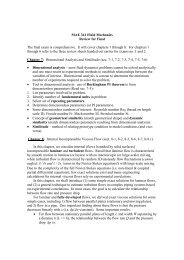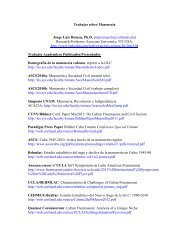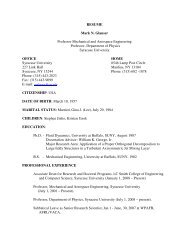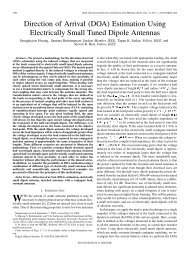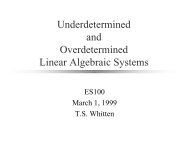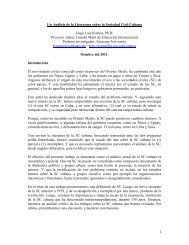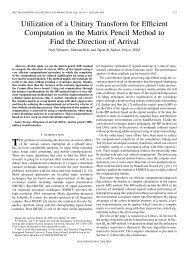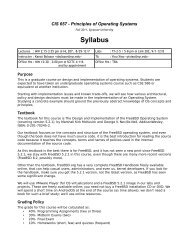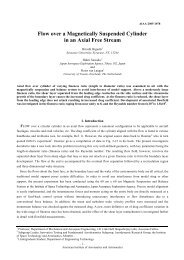On the optimal design of structured feedback gains - LC Smith ...
On the optimal design of structured feedback gains - LC Smith ...
On the optimal design of structured feedback gains - LC Smith ...
You also want an ePaper? Increase the reach of your titles
YUMPU automatically turns print PDFs into web optimized ePapers that Google loves.
<strong>On</strong> <strong>the</strong> <strong>optimal</strong> <strong>design</strong> <strong>of</strong> <strong>structured</strong> <strong>feedback</strong> <strong>gains</strong>for interconnected systemsMakan Fardad, Fu Lin, and Mihailo R. JovanovićAbstract— We consider <strong>the</strong> <strong>design</strong> <strong>of</strong> <strong>optimal</strong> static <strong>feedback</strong><strong>gains</strong> for interconnected systems subject to architectural constraintson <strong>the</strong> distributed controller. These constraints are in<strong>the</strong> form <strong>of</strong> sparsity requirements for <strong>the</strong> <strong>feedback</strong> matrix,which means that each controller has access to informationfrom only a limited number <strong>of</strong> subsystems. We derive necessaryconditions for <strong>the</strong> <strong>optimal</strong>ity <strong>of</strong> <strong>structured</strong> static <strong>feedback</strong><strong>gains</strong> in <strong>the</strong> form <strong>of</strong> coupled matrix equations. In general<strong>the</strong>se equations have multiple solutions, each <strong>of</strong> which is astationary point <strong>of</strong> <strong>the</strong> objective function. For stable open-loopsystems, we show that in <strong>the</strong> limit <strong>of</strong> expensive control, <strong>the</strong><strong>optimal</strong> controller can be found analytically using perturbationtechniques. We use this <strong>feedback</strong> gain to initialize homotopybasedgradient and Newton iterations that find an <strong>optimal</strong>solution to <strong>the</strong> original (non-expensive) control problem. Forunstable open-loop systems, <strong>the</strong> centralized truncated gain isused as an initial estimate for <strong>the</strong> iterative schemes aimed atfinding <strong>the</strong> <strong>optimal</strong> <strong>structured</strong> <strong>feedback</strong> gain. We consider bothspatially invariant and spatially varying problems and illustrateour developments with several examples.Index Terms— Architectural constraints, interconnected systems,<strong>optimal</strong> decentralized control, <strong>structured</strong> <strong>feedback</strong> <strong>gains</strong>.I. INTRODUCTIONLarge-scale systems are ubiquitous in nature and in modernengineering applications. The individual components<strong>of</strong> a large-scale system are <strong>of</strong>ten equipped with sensing,computation, and actuation capabilities. A central questionin <strong>the</strong> control <strong>of</strong> such systems <strong>the</strong>n becomes, what is a goodcommunication architecture between <strong>the</strong> controllers <strong>of</strong> <strong>the</strong>different subsystems? Clearly <strong>the</strong>re is a trade-<strong>of</strong>f in play: <strong>the</strong>best possible performance is attained if all controllers cancommunicate to each o<strong>the</strong>r, and as a whole decide upon<strong>the</strong> control action to be applied to each subsystem. This,however, comes at <strong>the</strong> expense <strong>of</strong> excessive communicationand computation requirements. The o<strong>the</strong>r extreme is whenevery controller acts in isolation, and applies a controlaction to its corresponding subsystem based on its ownmeasurement <strong>of</strong> <strong>the</strong> subsystem’s output. This scenario placesminimum communication and computation requirements on<strong>the</strong> controllers, but generally comes at <strong>the</strong> expense <strong>of</strong> poorperformance.A desired scenario, and a reasonable middle ground, is <strong>the</strong>local communication <strong>of</strong> subsystems with <strong>the</strong>ir immediate ornearest neighbors, referred to as localized control. It is thistype <strong>of</strong> decentralized control that is <strong>the</strong> focus <strong>of</strong> <strong>the</strong> presentresearch effort.Financial support from <strong>the</strong> National Science Foundation under CAREERAward CMMI-06-44793 and under Award CMMI-09-27720 is gratefullyacknowledged.M. Fardad is with <strong>the</strong> Department <strong>of</strong> Electrical Engineering and ComputerScience, Syracuse University, NY 13244. F. Lin and M. R. Jovanovićare with <strong>the</strong> Department <strong>of</strong> Electrical and Computer Engineering, University<strong>of</strong> Minnesota, Minneapolis, MN 55455. E-mails: makan@syr.edu,fu@umn.edu, mihailo@umn.edu.The syn<strong>the</strong>sis problem <strong>of</strong> distributed control for interconnectedsystems has received considerable attention inrecent years [1]–[14]. For linear spatially invariant plants,it was shown in [1] that <strong>optimal</strong> controllers are <strong>the</strong>mselvesspatially invariant. Fur<strong>the</strong>rmore, for <strong>optimal</strong> distributed problemswith quadratic performance indices <strong>the</strong> dependence<strong>of</strong> a controller on information coming from o<strong>the</strong>r parts <strong>of</strong><strong>the</strong> system decays exponentially as one moves away fromthat controller [1]. These developments motivate <strong>the</strong> searchfor inherently localized controllers. For example, one couldsearch for <strong>optimal</strong> controllers that are subject to <strong>the</strong> conditionthat <strong>the</strong>y communicate only to o<strong>the</strong>r controllers within acertain radius. However, <strong>the</strong> framework <strong>of</strong> [1] does not allow<strong>the</strong> a priori specification <strong>of</strong> <strong>the</strong> communication architecture<strong>of</strong> <strong>the</strong> distributed controller. Additionally, it does not provideerror bounds on <strong>the</strong> deviation from <strong>optimal</strong>ity if one wereto truncate <strong>the</strong> information dependence <strong>of</strong> every controller,for example by confining it to communicating within a prespecifiedradius <strong>of</strong> itself.Thus <strong>the</strong> problem <strong>of</strong> controller <strong>design</strong> for large-scale anddistributed systems is mostly dominated by <strong>the</strong> architecturaland localization constraints imposed on <strong>the</strong> controller. Such<strong>design</strong> problems are well-known to be difficult, with almostthree decades <strong>of</strong> research in an area that has come to beknown as <strong>the</strong> ‘decentralized control <strong>of</strong> large-scale systems’;see [15] and references <strong>the</strong>rein.A problem <strong>of</strong> wide interest is to search for an <strong>optimal</strong>distributed controller that is a static gain (i.e., has no temporaldynamics) with a priori assigned localization constraints.Such controllers are less sophisticated than dynamic controllers,and thus may achieve lower performance, but have<strong>the</strong> advantage <strong>of</strong> being much easier to implement. Mostarchitectural requirements on <strong>the</strong> distributed static controllerare in <strong>the</strong> form <strong>of</strong> sparsity constraints. We focus particularlyon cases where <strong>the</strong> static <strong>feedback</strong> gain can be partitionedinto banded matrices, which are non-zero only on <strong>the</strong> maindiagonal and a relatively small number <strong>of</strong> sub-diagonals.Such banded structure translates to each controller using onlylocal information to compute <strong>the</strong> control action. We searchfor <strong>structured</strong> controllers that minimize <strong>the</strong> H 2 norm. We finda coupled set <strong>of</strong> algebraic matrix equations that characterizenecessary conditions for <strong>the</strong> <strong>optimal</strong>ity <strong>of</strong> <strong>the</strong> <strong>structured</strong> staticcontroller.The challenging aspect <strong>of</strong> solving <strong>the</strong> aforementionedcoupled equations is that <strong>the</strong>y can have multiple solutions,each <strong>of</strong> which is a stationary point <strong>of</strong> <strong>the</strong> norm minimizationproblem. In general, it is not known how many local minimaexist or how to find <strong>the</strong>m. For stable open-loop systems, weconsider <strong>the</strong> case <strong>of</strong> expensive control [16] in which a perturbationanalysis <strong>of</strong> <strong>the</strong> necessary conditions for <strong>optimal</strong>itycan be performed. The expensive control scenario restricts<strong>the</strong> norm <strong>of</strong> <strong>the</strong> distributed gain as it tries to minimize
<strong>the</strong> use <strong>of</strong> control effort. Perturbation analysis results inequations that are decoupled and thus readily solvable t<strong>of</strong>ind expansion terms <strong>of</strong> arbitrarily high-order. This leadsto a unique <strong>optimal</strong> gain that is small in norm; this gaincan be used to initialize a homotopy-based gradient andNewton iterations to determine <strong>optimal</strong> controller for smallervalues <strong>of</strong> control penalty. In this numerical scheme <strong>the</strong>level <strong>of</strong> expensiveness <strong>of</strong> <strong>the</strong> control problem is successivelyreduced and <strong>the</strong> resulting matrix equations are solved until<strong>the</strong> original (non-expensive) control objective is recovered.For unstable open-loop systems, we apply a spatial truncationon <strong>the</strong> <strong>optimal</strong> centralized <strong>feedback</strong> gain to initialize aniterative numerical scheme that is aimed at solving necessaryconditions for <strong>optimal</strong>ity subject to structural constraints.An interesting example <strong>of</strong> this procedure arises in <strong>the</strong> case<strong>of</strong> spatially invariant systems; for such systems <strong>the</strong> <strong>optimal</strong>static <strong>feedback</strong> is a centralized gain whose spatial dependencedecays exponentially with distance [1]. We <strong>the</strong>reforeexpect that <strong>the</strong> truncated gain would be a reasonable initialestimate for <strong>the</strong> Newton-based iterative scheme that attemptsto find <strong>the</strong> <strong>optimal</strong> <strong>structured</strong> <strong>feedback</strong> gain.The paper is organized as follows: in Section II <strong>the</strong><strong>structured</strong> <strong>optimal</strong> control problem is formulated and necessaryconditions for <strong>optimal</strong>ity are found. In Section IIIwe consider stable open-loop systems and apply a perturbationanalysis on <strong>the</strong>se necessary conditions to find <strong>the</strong>unique <strong>optimal</strong> expensive static controller. In Section IVgradient- and Newton-based iterative schemes are used t<strong>of</strong>ind stabilizing (locally) <strong>optimal</strong> distributed controllers. InSection V we provide illustrative examples, and in Section VIwe summarize our developments.II. NECESSARY CONDITIONS FOR OPTIMALITYConsider <strong>the</strong> control problem˙ψ = A ψ + B 1 w + B 2 u,z = C 1 ψ + D u,y = C 2 ψ, u = −F y,where C 1 = [ Q 1/2 0 ] ∗ [ ]and D = 0 R1/2 ∗. Thematrix F denotes <strong>the</strong> static <strong>feedback</strong> gain which is subject tostructural constraints. Specifically, <strong>the</strong> structural constraintsdictate <strong>the</strong> zero entries <strong>of</strong> <strong>the</strong> <strong>feedback</strong> gain. We assume that<strong>the</strong> subspace S encapsulates <strong>the</strong>se constraints and that <strong>the</strong>reis a stabilizing F ∈ S.Upon closing <strong>the</strong> loop, <strong>the</strong> above problem can equivalentlybe written as˙ψ = (A − B 2 F C 2 ) ψ + B 1 w,[]Qz =1/2(H2)−R 1/2 ψ.F C 2Note that w denotes exogenous signals and that <strong>the</strong> performanceoutput z encapsulates both <strong>the</strong> amplitude <strong>of</strong> <strong>the</strong> stateand that <strong>of</strong> <strong>the</strong> control input. We now consider <strong>the</strong> following<strong>optimal</strong> control problem:• Find <strong>the</strong> matrix F ∈ S such that ‖H‖ 2 2 is minimized,where H is <strong>the</strong> transfer function from w to z and ‖ · ‖ 2is <strong>the</strong> H 2 norm.It can be shown [17] that this <strong>optimal</strong> control problem isequivalent tominimize J = trace (P B 1 B ∗ 1)subject to (A − B 2 F C 2 ) ∗ P + P (A − B 2 F C 2 )= − (Q + C ∗ 2 F ∗ RF C 2 ) , F ∈ S.(SG)Note that <strong>the</strong> first constraint in (SG) is nothing but <strong>the</strong>Lyapunov equation A ∗ cl P + P A cl = −C ∗ cl C cl correspondingto <strong>the</strong> closed-loop system (H2). We remark that – when <strong>the</strong>reare no structural constraints on F – <strong>the</strong> above problem isstrongly related to <strong>the</strong> static output-<strong>feedback</strong> LQR problemconsidered in [18].Most structural requirements on <strong>the</strong> gain F are in <strong>the</strong>form <strong>of</strong> sparsity constraints. A sparse matrix is populatedprimarily with zeros and <strong>the</strong> pattern <strong>of</strong> <strong>the</strong> non-zero entriesdescribes <strong>the</strong> communication architecture <strong>of</strong> <strong>the</strong> distributedcontroller; if <strong>the</strong> ijth block <strong>of</strong> F is non-zero it means thatsubsystem j is communicating its state to <strong>the</strong> controller <strong>of</strong><strong>the</strong> ith subsystem. We focus particularly on cases whereF is a banded matrix, i.e., it is only non-zero on its mainblock-diagonal and a relatively small number <strong>of</strong> block subdiagonals.For vehicular platoons, such a banded structuretranslates to each vehicle using only information about<strong>the</strong> position and velocity <strong>of</strong> a relatively small number <strong>of</strong>neighboring vehicles to control its own position and velocity.Theorem 1 (Necessary conditions for <strong>optimal</strong>ity):In order for matrix F ∈ S, with A − B 2 F C 2 Hurwitz, to be<strong>optimal</strong> for <strong>the</strong> problem (SG) it is necessary that it satisfies<strong>the</strong> following set <strong>of</strong> equations:(A − B 2 F C 2 ) ∗ P + P (A − B 2 F C 2 )= − (Q + C ∗ 2 F ∗ RF C 2 ) , (NC1)(A − B 2 F C 2 ) L + L (A − B 2 F C 2 ) ∗ = −B 1 B ∗ 1, (NC2)(RF C 2 <strong>LC</strong> ∗ 2 ) ◦ I S = (B ∗ 2P <strong>LC</strong> ∗ 2 ) ◦ I S , (NC3)where ◦ denotes <strong>the</strong> element-wise multiplication <strong>of</strong> matricesand <strong>the</strong> matrix I S is defined as{ 1 if Fij is a free variable,[I S ] ij=0 if F ij = 0 is required.Remark 1: Similar necessary conditions for <strong>optimal</strong>ity <strong>of</strong>fixed-order dynamic controllers appear in [19]. To differentiateour results from those <strong>of</strong> [19], we note that <strong>the</strong> equivalent<strong>of</strong> equation (NC3) in [19] is given in <strong>the</strong> form <strong>of</strong> summation<strong>of</strong> matrix multiplications, which is much more expensive tocompute than (NC3). Fur<strong>the</strong>r, for stable open-loop systemswe develop homotopy-based descent method by utilizing<strong>the</strong> perturbation analysis in <strong>the</strong> limit <strong>of</strong> expensive control.Also, <strong>the</strong> Newton direction for <strong>the</strong> <strong>design</strong> <strong>of</strong> static <strong>structured</strong><strong>feedback</strong> <strong>gains</strong> is determined for <strong>the</strong> first time in our work.We consider (NC3) for a few important examples <strong>of</strong> S:• S is <strong>the</strong> subspace <strong>of</strong> diagonal matrices. In this caseI S = I. The <strong>optimal</strong>ity condition (NC3) becomes(RF C 2 <strong>LC</strong> ∗ 2 ) ◦ I = (B ∗ 2P <strong>LC</strong> ∗ 2 ) ◦ I,which can also be written as diag {RF C 2 <strong>LC</strong> ∗ 2 } =diag {B ∗ 2P <strong>LC</strong> ∗ 2 }.• S is <strong>the</strong> subspace <strong>of</strong> tridiagonal matrices. In this caseI S = T , where T is <strong>the</strong> tridiagonal matrix with elementsequal to one on <strong>the</strong> main diagonal, first upper, and firstlower subdiagonals. The <strong>optimal</strong>ity condition (NC3)
O(1) : F (0) = 0⎧⎪⎨ A ∗ P (0) + P (0) A = −QO(ε) :⎪⎩⎧⎪⎨O(ε 2 ) :⎪⎩.AL (0) + L (0) A ∗ = −B 1 B1∗F (1) = ([B2P ∗ (0) L (0) C2 ∗ ] ◦ I) ([C 2 L (0) C2 ∗ ] ◦ I) −1A ∗ P (1) + P (1) A = (B 2 F (1) C 2 ) ∗ P (0) + P (0) (B 2 F (1) C 2 ) − C ∗ 2 F (1)∗ F (1) C 2AL (1) + L (1) A ∗F (2)= (B 2 F (1) C 2 ) L (0) + L (0) (B 2 F (1) C 2 ) ∗= ([B ∗ 2P (0) L (1) C ∗ 2 + B ∗ 2P (1) L (0) C ∗ 2 − F (1) C 2 L (1) C ∗ 2 ] ◦ I) ([C 2 L (0) C ∗ 2 ] ◦ I) −1.(EXP)ei<strong>the</strong>r <strong>the</strong> negative gradient direction, F d = −F g , or <strong>the</strong>Newton direction, F d = F nt , we next employ <strong>the</strong> standardbacktracking line search, with parameters α = 0.3 andβ = 0.5 (see [21, p. 464]), to determine <strong>the</strong> step-size. Inaddition to providing decrease in J, it is also necessary toguarantee <strong>the</strong> closed-loop stability when selecting <strong>the</strong> stepsize.Hence, given descent direction F d and step-size s = 1:Stepsize searchrepeat: s := βsuntil: both conditions are satisfied1) J(F + sF d ) < J(F ) + α s trace(∇J(F ) T F d );2) A cl = A − B 2 (F + sF d )C 2 is Hurwitz.Iterative algorithmGiven a stabilizing F 0 , <strong>the</strong> iterative algorithm at each stepk is given by1) compute descent direction F d (F k );2) use step-size search to determine s k ;3) update F k+1 = F k + s k F d (F k ).until: stopping criterion ‖∇J(F k )‖ 2 < ɛ is reached.C. Homotopy-based iterationsFor stable open-loop systems, <strong>the</strong> <strong>design</strong> procedure <strong>of</strong> SectionIII can be extended to non-expensive control regimes via<strong>the</strong> use <strong>of</strong> homotopy (i.e., continuation) methods. Homotopymethods are based on replacing <strong>the</strong> problem <strong>of</strong> interest by aparameterized family <strong>of</strong> problems with following properties:(i) <strong>the</strong> problem is easily solved for small values <strong>of</strong> <strong>the</strong>parameter; and (ii) as <strong>the</strong> parameter value is increased <strong>the</strong>problem transforms into <strong>the</strong> problem <strong>of</strong> interest.We thus consider <strong>the</strong> following iterative scheme to find <strong>the</strong><strong>optimal</strong> <strong>structured</strong> F that solves optimization problem (SG).Let R = (1/ε) I, where ε is a positive scalar and I is<strong>the</strong> identity matrix. Treating ε as <strong>the</strong> homotopy parameter,we first find <strong>the</strong> <strong>optimal</strong> <strong>structured</strong> F that minimizes (SG)for very small values <strong>of</strong> ε. This has <strong>the</strong> interpretation <strong>of</strong>expensive control [16]; a small ε results in a large R, whichin light <strong>of</strong> <strong>the</strong> output matrix in (H2) means that controleffort has to be spent sparingly. The solution <strong>of</strong> this problemresults in a <strong>structured</strong> <strong>feedback</strong> gain F that is small in normand is computed easily and reliably using MATLAB (for verysmall ε, <strong>the</strong> matrix F can be computed using <strong>the</strong> perturbationanalysis <strong>of</strong> Section III). We now slightly increase <strong>the</strong> value<strong>of</strong> ε and use <strong>the</strong> obtained F to initialize <strong>the</strong> next round<strong>of</strong> gradient or Newton iterations. We continue increasing<strong>the</strong> value <strong>of</strong> ε until <strong>the</strong> matrix R <strong>of</strong> <strong>the</strong> original controlobjective is recovered. This algorithm effectively guides <strong>the</strong>optimization scheme through <strong>the</strong> many local minima.V. EXAMPLESA. Spatially varying mass-spring systemIn this section we revisit a mass-spring system on a linedescribed in Example 1. The centralized <strong>optimal</strong> controller,u = −Kψ, is given by K = R −1 B ∗ 2X, where X is <strong>the</strong>positive definite solution <strong>of</strong> <strong>the</strong> algebraic Riccati equationA ∗ X + XA + Q − XB 2 R −1 B ∗ 2X = 0.The initial <strong>feedback</strong> gain F 0 is determined by projecting Konto <strong>the</strong> information structure S, that isF 0 = [ F 0p F 0v ] = K ◦ [ S p I ].It turns out that F 0 for any p ≥ 0 is a stabilizing <strong>feedback</strong>gain. Thus, <strong>the</strong> iterative descent algorithm <strong>of</strong> Section IV-Acan be initialized with F 0 . We note that o<strong>the</strong>r approacheshave been developed to find a stabilizing <strong>feedback</strong> gain [7].The stopping criterion for <strong>the</strong> algorithms is ‖∇J(F )‖ 2
(a)Fig. 2. Comparison <strong>of</strong> elements on <strong>the</strong> main diagonals <strong>of</strong>: (a) initial and<strong>optimal</strong> position <strong>feedback</strong> <strong>gains</strong>; (b) initial and <strong>optimal</strong> velocity <strong>feedback</strong><strong>gains</strong>. Mass-spring system <strong>of</strong> Example 1 with {p = 1, N = 50, Q = I,R = 10I} is considered.(a)Fig. 3. Scaling <strong>of</strong> ‖ ¯H‖ 2 2 := (1/N)‖H‖2 2 with <strong>the</strong> number <strong>of</strong> vehiclesN for: (a) truncated <strong>optimal</strong> centralized controller (dashed) and <strong>structured</strong>controller (solid) with spatial spread p = 4; (b) <strong>structured</strong> (with spatialspread p = {1, 2, 3, 4}) and centralized state-<strong>feedback</strong> controllers.B. System <strong>of</strong> single integrator vehicles on circleWe next consider <strong>the</strong> <strong>design</strong> <strong>of</strong> <strong>structured</strong> controllers<strong>of</strong> spatial spread p for a system <strong>of</strong> identical single integratorvehicles described in Example 2 with C 2θ =[ 2 (1 − cos (2πθ/N)) · · · 2 (1 − cos (2πp θ/N)) ] ∗ , F =[ f 1 · · · f p ] , and <strong>the</strong> following pair <strong>of</strong> state/control weights(Q θ , r) = (2 (1 − cos (2πθ/N)) , 1). The selected statepenalty accounts for <strong>the</strong> difference between <strong>the</strong> position <strong>of</strong>vehicle n and <strong>the</strong> average <strong>of</strong> positions <strong>of</strong> two neighboringvehicles. In this case, <strong>the</strong> <strong>optimal</strong> centralized state-<strong>feedback</strong>controller, u θ = −K θ ψ θ , is given by K θ = Q 1/2θ, and <strong>the</strong> <strong>optimal</strong><strong>structured</strong> controller with p = 1 is given in Example 2.To determine <strong>the</strong> <strong>structured</strong> controller with p ≥ 2, we applyNewton’s method to solving (NC’) by initiating <strong>the</strong> iterationswith a truncated centralized controller. Figure 3(a) illustrates<strong>the</strong> performance comparison <strong>of</strong> <strong>the</strong> truncated centralized controllerand <strong>the</strong> <strong>structured</strong> controller with spatial spread p = 4;clearly, Newton’s iteration provides appreciable performanceimprovement relative to <strong>the</strong> truncated centralized controller.The performance <strong>of</strong> <strong>structured</strong> controllers with spatial spreadp = {1, 2, 3, 4} (obtained by applying Newton’s methodto (NC’)) and <strong>optimal</strong> centralized controller is shown inFig. 3(b). As expected, an increase in <strong>the</strong> spatial spreaddecreases <strong>the</strong> performance gap between <strong>optimal</strong> <strong>structured</strong>and <strong>optimal</strong> centralized <strong>design</strong>s.VI. CONCLUSIONSWe study <strong>the</strong> static H 2 syn<strong>the</strong>sis problem subject to <strong>the</strong><strong>feedback</strong> gain satisfying certain sparsity constraints. Theseconstraints are such that <strong>the</strong>y enforce a localized communicationarchitecture between <strong>the</strong> underlying plant and <strong>the</strong>controller. We find necessary conditions for <strong>optimal</strong>ity <strong>of</strong>(b)(b)localized controllers that are in <strong>the</strong> form <strong>of</strong> coupled matrixequations. In general <strong>the</strong>se equations have multiple solutions,which correspond to different stationary points. However, forstable open-loop systems, in <strong>the</strong> limit <strong>of</strong> expensive control,perturbation methods can be used to find a unique <strong>optimal</strong>controller. We use this controller to initialize a homotopybasednumerical optimization scheme that determines <strong>optimal</strong>controller in <strong>the</strong> non-expensive regime. For unstableopen-loop systems, an iterative scheme utilizing gradientand Newton’s methods is employed to determine a solutionto stationary conditions for <strong>optimal</strong>ity. The iterations areinitialized by projecting <strong>optimal</strong> centralized controllers to<strong>the</strong> set <strong>of</strong> controllers with desired localization properties.The presented algorithms appear to work well in practiceas demonstrated by illustrative examples in Section V.REFERENCES[1] B. Bamieh, F. Paganini, and M. A. Dahleh, “Distributed control <strong>of</strong>spatially invariant systems,” IEEE Trans. Automat. Control, vol. 47,no. 7, pp. 1091–1107, 2002.[2] G. A. de Castro and F. Paganini, “Convex syn<strong>the</strong>sis <strong>of</strong> localizedcontrollers for spatially invariant system,” Automatica, vol. 38, pp.445–456, 2002.[3] P. G. Voulgaris, G. Bianchini, and B. Bamieh, “Optimal H 2 controllersfor spatially invariant systems with delayed communicationrequirements,” Syst. Control Lett., vol. 50, pp. 347–361, 2003.[4] R. D’Andrea and G. E. Dullerud, “Distributed control <strong>design</strong> forspatially interconnected systems,” IEEE Trans. Automat. Control,vol. 48, no. 9, pp. 1478–1495, 2003.[5] G. Dullerud and R. D’Andrea, “Distributed control <strong>of</strong> heterogeneoussystems,” IEEE Trans. Automat. Control, vol. 49, no. 12, pp. 2113–2128, December 2004.[6] C. Langbort, R. S. Chandra, and R. D’Andrea, “Distributed control<strong>design</strong> for systems interconnected over an arbitrary graph,” IEEETrans. Automat. Control, vol. 49, no. 9, pp. 1502–1519, September2004.[7] V. Gupta, B. Hassibi, and R. M. Murray, “<strong>On</strong> <strong>the</strong> syn<strong>the</strong>sis <strong>of</strong> controllaws for a network <strong>of</strong> autonomous agents,” in Proceedings <strong>of</strong> <strong>the</strong> 2004American Control Conference, 2004, pp. 4927–4932.[8] B. Bamieh and P. G. Voulgaris, “A convex characterization <strong>of</strong> distributedcontrol problems in spatially invariant systems with communicationconstraints,” Syst. Control Lett., vol. 54, pp. 575–583, 2005.[9] M. Rotkowitz and S. Lall, “A characterization <strong>of</strong> convex problems indecentralized control,” IEEE Trans. Automat. Control, vol. 50, no. 12,pp. 1984–1996, 2005.[10] A. Rantzer, “Linear quadratic team <strong>the</strong>ory revisited,” in Proceedings<strong>of</strong> <strong>the</strong> 2006 American Control Conference, 2006, pp. 1637–1641.[11] ——, “A separation principle for distributed control,” in Proceedings<strong>of</strong> <strong>the</strong> 45th IEEE Conference on Decision and Control, 2006, pp. 3609–3613.[12] N. Motee and A. Jadbabaie, “Optimal control <strong>of</strong> spatially distributedsystems,” IEEE Trans. Automat. Control, vol. 53, no. 7, pp. 1616–1629, Aug. 2008.[13] F. Borrelli and T. Keviczky, “Distributed LQR <strong>design</strong> for identical dynamicallydecoupled systems,” IEEE Trans. Automat. Control, vol. 53,no. 8, pp. 1901–1912, Sept. 2008.[14] M. Fardad and M. R. Jovanović, “<strong>On</strong> <strong>the</strong> state-space <strong>design</strong> <strong>of</strong> <strong>optimal</strong>controllers for distributed systems with finite communication speed,”in Proceedings <strong>of</strong> <strong>the</strong> 47th IEEE Conference on Decision and Control,2008, pp. 5488–5493.[15] D. D. Šiljak, Decentralized Control <strong>of</strong> Complex Systems. AcademicPress, 1991.[16] T. Kailath, Linear Systems. Prentice Hall, 1979.[17] K. Zhou, J. Doyle, and K. Glover, Robust and Optimal Control.Prentice Hall, 1996.[18] W. S. Levine and M. Athans, “<strong>On</strong> <strong>the</strong> determination <strong>of</strong> <strong>the</strong> <strong>optimal</strong>constant output <strong>feedback</strong> <strong>gains</strong> for linear multivariable systems,” IEEETrans. Automat. Control, vol. 15, no. 1, pp. 44–48, 1970.[19] C. J. Wenk and C. H. Knapp, “Parameter optimization in linear systemswith arbitrarily constrained controller structure,” IEEE Trans. Automat.Control, vol. 25, pp. 496–500, 1980.[20] D. P. Bertsekas, Nonlinear programming. A<strong>the</strong>na Scientific, 1999.[21] S. Boyd and L. Vandenberghe, Convex Optimization. CambridgeUniversity Press, 2004.[22] R. A. Horn and C. R. Johnson, Topics in Matrix Analysis. CambridgeUniversity Press, 1994.




